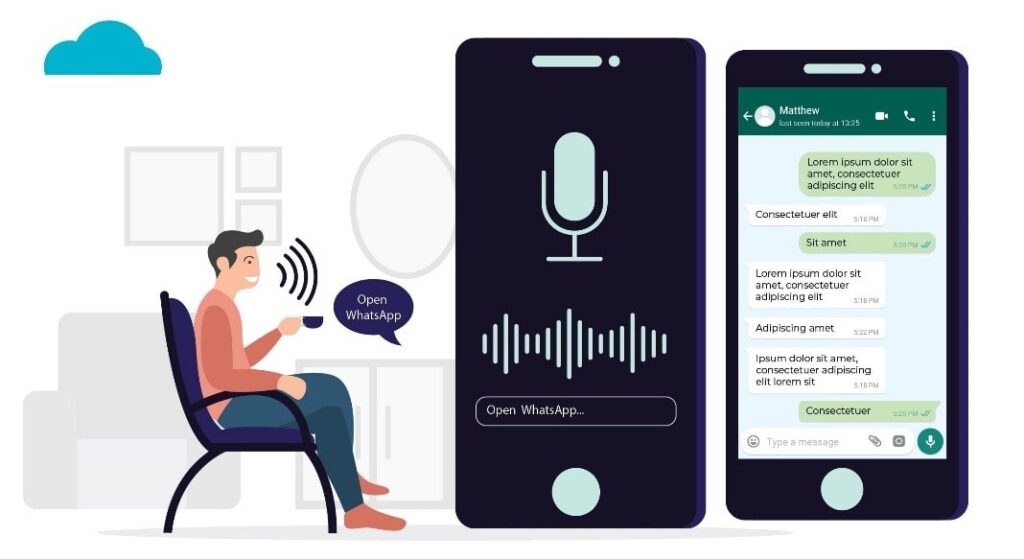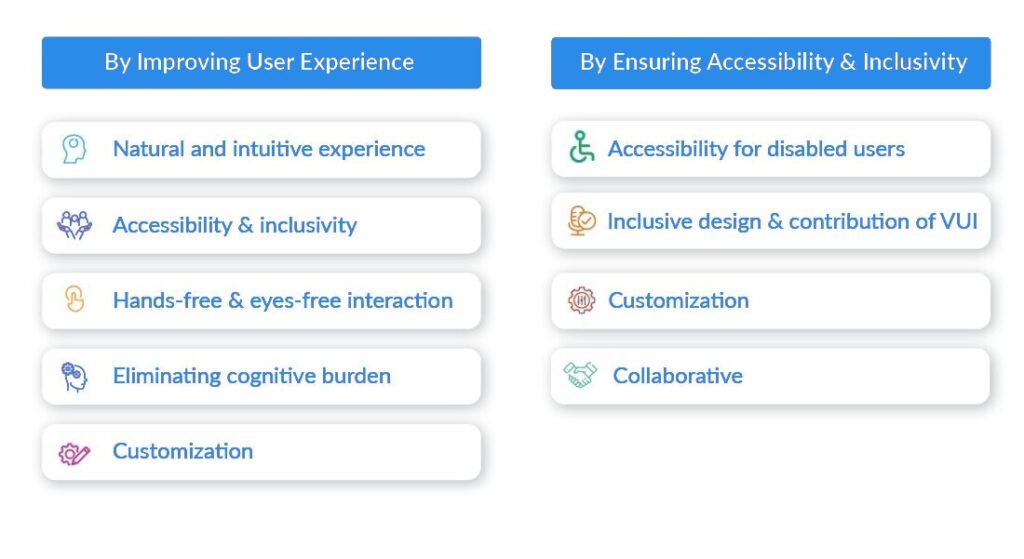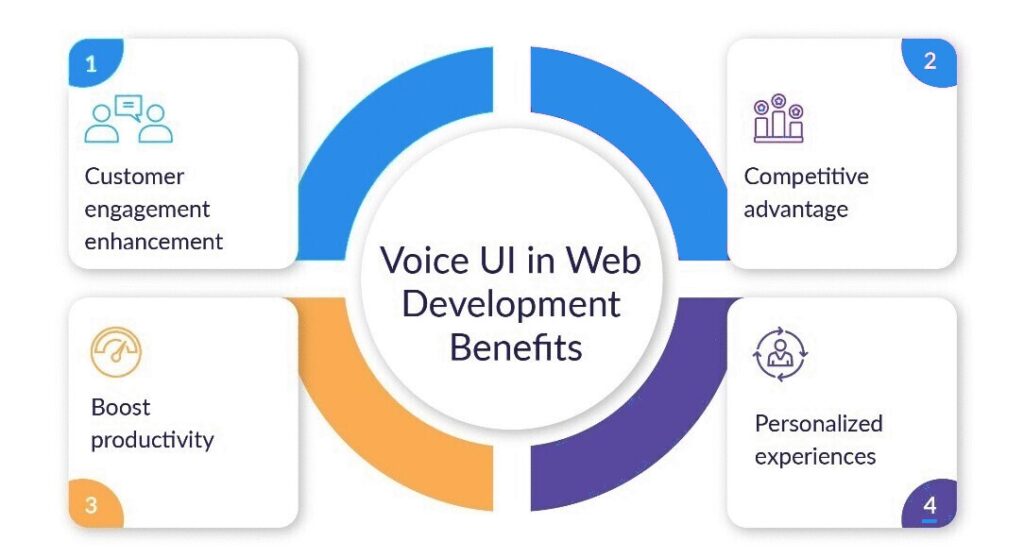How Can You Transform the Voice User Interface in your Web Development?

Quick Summary:
In the past, people used to interact with computers by typing text commands through keyboards, known as Character User Interface or CUI. As technology progressed, we transitioned to a Graphical User Interface (GUI), where we became familiar with using buttons, icons, and menus to interact with digital products. However, as time passed, our preferences changed, and we began prioritizing convenience. As a result, Voice User Interface (VUI) has now become widespread and is impacting our daily lives. In this blog post, we will discuss the significant shift from GUI to VUI.
Table of Contents
Introduction to Voice User Interface (VUI)
Do you remember Jarvis from Iron Man?
It was an incredible experience witnessing Tony Stark effortlessly control machines with voice commands. The interaction between him and the machines felt effortless and smooth. At the time, it seemed like a fantasy and impossible, but now it has become a reality. The potential of the voice-based user interface known as Jarvis is so vast that it has gained worldwide recognition. Voice User Interface The industry is anticipated to experience an immense increase and reach close to $46 Billion by 2027.
As the conversational interface or VUI is rapidly gaining popularity, it is evident that activities like scrolling, tapping, and typing will soon become obsolete. The way we navigate digital platforms is shifting from requiring our constant focus to solely relying on our voice commands. Elevate Your Digital Presence with Our Expert UI/UX Design Services.
Investing in VUI (voice user interface) in web development is a wise choice considering the ever-changing IT environment. This is because it is the future and the way it will progress.
Continue to read the blog as it will provide you with all the necessary information to determine whether utilizing Voice User Interface in web development is beneficial.
Overview of Voice User Interface
Voice User Interface (VUI) technology transforms the way people interact with computers by allowing them to communicate through speech recognition. Prominent examples of VUIs include Siri by Apple, Alexa by Amazon, Assistant by Google, and Cortana by Microsoft. What makes VUI unique is that it relies on voice commands as the main method of interaction, moving away from traditional setups like keyboard mouse monitors or touch screens. By prioritizing voice, users can make automated services quicker and perform daily tasks effortlessly, enhancing their digital experience. Now, let’s explore the elements of voice UI.
Voice User Interface Components
We have listed down four voice UI components that convey spoken information by humans to machines, and then, the latter transcribes it to execute the command.
1. Automatic Speech Recognition (ASR)
The technology transforms spoken language, voice commands, and audio into written texts. This Voice User Interface (UI) element guarantees that the system comprehends voice commands, queries, and prompts.
Thanks to the utilization of machine learning and advanced algorithms, the audio waveform can be comprehensively analyzed and converted into written text. This entire process consists of several distinct steps, namely Preprocessing, Acoustic modeling, Language modeling, Decoding, and Post-processing.
2. Natural Language Understanding (NLU)
One more element of the voice user interface is natural language understanding. This component guarantees precise interpretation and comprehension of the specific intention behind human language input. NLU allows the machine to understand and respond to the user’s language, whether it is spoken or written.
There are various techniques and algorithms in Natural Language Understanding (NLU) that help examine the user’s language. These include Syntax Analysis, Semantic Understanding, Intent Recognition, Contextual Understanding, and Slot Filling.
3. Text to Speech
As the name suggests, the technology ensures the transcription of textual language to speech. The technology makes digital platforms generate synthesized speech output through which users will be able to understand in an audible format. This voice UI component is quite crucial in voice-based communication channels.
Let’s understand how text-to-speech works:
- Text processing
- Linguistic analysis
- Prosody modeling
- Speech synthesis
- Voice selection
- Output delivery
4. Dialog Management
This Voice User Interface The responsible part manages the interaction between the user and the system, ensuring accurate control of requests, answers, and the overall conversation, thereby facilitating interactive communication.
Below are the significant aspects of Dialog Management:
- Context tracking
- Prompting & user input
- Intent recognition
- System response generation
- Multi-turn conversation
- Error handling and recovery
Now that you know the elements of voice UI, let us explore the functionality of this modern technology.
How Does Voice User Interface Work?
The user interface (UI) employs voice recognition technology, allowing users to communicate with digital systems using their voice. This means that users can interact with devices, virtual assistants, and mobile/web-based apps by giving voice commands or speaking in a language. In addition to being convenient and user-friendly, this technology eliminates the need for physical or manual input, making it more intuitive.
Let’s understand how the Voice User Interface works:

Hope that you have got an idea about the working of the Voice User Interface. With that, let’s look at some current Voice User Interface use cases (VUI).
Voice User Interface (VUI) Use Cases
Voice-based interface technology has been in existence for quite some time, indicating its familiarity and extensive usage. Consequently, it is important to familiarize oneself with various examples of voice UI applications to determine the direction for future project development.
Voice Search & Virtual Assistants
In today’s world, voice search has become a popular application. It allows users to search for information on the Internet using their voice. Examples of voice search platforms include Siri, Alexa, and Google Assistant, which respond to your commands and offer personalized experiences such as playing your favorite Netflix show or controlling the AC.
Were you aware that more than 150 million smart speakers will be installed globally in 2023?
Furthermore, it is projected that by the conclusion of 2024, there will be a total of 8 billion voice assistants in usage worldwide.
Smart-Home Integrations
Another great VUI use case is smart-home integrations that also contribute to the revolution of smart homes and interactions. You can control your light, AC, thermostat, security, and all possible connected devices via voice command through the intelligent home. It enables hands-free and eyes-free convenience for home automation, ensuring ease and swiftness in daily tasks.
The fact is, that 77% of smart speaker owners control smart devices in their homes using voice commands.
Automotive Voice Control
Controlling the car through voice commands is one of the greatest inventions and use cases of all time. Since drivers are already occupied with several tasks, interacting with various functions and features of a vehicle using voice commands is a great relief. With Automotive Voice Control, drivers can control audio systems, make phone calls, navigate directions, adjust climate settings, and perform other tasks without taking their hands off the steering wheel or eyes off the road.
Example: BMW has developed a virtual assistant called “BMW Intelligent Personal Assistant”, that allows drivers to interact with different vehicle features using voice commands, thereby enabling hands-free control over the car functions.
Customer Support & Virtual Agents
These days, many companies prefer chatbots powered by artificial intelligence (AI) to provide customer support and assistance. These virtual assistants are designed to mimic human-like conversations for interacting with consumers to address their queries. Most of the time, natural language processing and machine learning algorithms are used to develop virtual agents, so they can understand customer queries and respond with relevant and accurate information. These days, many companies prefer chatbot integration to enhance customer experience.
For example, KLM Royal Dutch Airlines uses a chatbot named BlueBot. It interacts with customers through various messaging platforms like Facebook Messenger and WhatsApp.
Now that you know the VUI use cases, let’s understand the impact of Voice UI on web development.
Want to make your application voice-enabled?
Hire web developers to implement Voice User Interface into your web development projects and unlock the potential of voice technology for your business.
How Voice UI Impacts Web Development?
The web development process is influenced by the Voice User Interface, which improves the convenience and efficiency of the user’s experience, ultimately resulting in the creation of an intuitive application.
First, let’s understand how this technology that allows users to operate hands-free and without using their eyes enhances their experience.

By Improving User Experience
The prime objective of voice UI is to enhance user experience, and when combined with web development, the results are outstanding. Below are the five ways to improve user experience.
Natural and Intuitive Experience
Voice interaction is one of the natural ways of interacting. Since speaking is the natural form, voice UI leverages this to make the interaction with digital platforms seamless. You just have to speak, and technology gets familiar with the patterns. This user interface form eliminates the challenges of graphical user interfaces and other complex methods.
Accessibility & Inclusivity
Unlike a graphical user interface (GUI), using voice commands overcomes the challenges that disallow disabled users to interact with the systems. The voice-based interaction mode is excellent for disabled users since they can leverage the technology and make their lives easier; many disabled audiences can leverage this voice UI technology. Navigation through web content is also possible seamlessly for physically disabled users.
Hands-Free & Eyes-Free Interaction
As said, no physical touch or attention is required with the voice-based user interface. Voice UI in web development has turned out to be gaining popularity because of its convenience. Unlike a graphical user interface requiring physical intervention, this one is great even for the most complex tasks. VUI is one of the swiftest methods for interaction with digital platforms.
Eliminating Cognitive Burden
Voice User Interfaces in web development are far better than graphical interfaces. In this UI, users must speak and not navigate through the tabs. This saves a lot of time that might have been wasted physically navigating. It automates and streamlines users’ journeys and enhances experiences.
Customization
Using VUI, you can expect customized web experiences using voice commands and user choices. It can even deliver personalized content, responses, and suggestions from the VUI. Personalization ensures user experience enhancement using customized interactions. This way, users will feel more comfortable and engaged.
Now that you know how the technology improves user experience, let us know how accessible and inclusive is the Voice User Interface.
By Ensuring Accessibility & Inclusivity
This is a section wherein we will discuss about visually or physically disabled users will be able to interact with digital platforms. Understand how your voice-enabled web app will uplift disabled users’ experience.
1. Accessibility for Disabled Users
Even if your target audience is disabled in any way from the following possibilities, they still can access Voice User Interface to interact with digital platforms, smart homes, or electronic devices.
Motor Disabilities
What was once inaccessible for users suffering from motor disabilities or dexterity is now a thing of the past. The advancement of technology has made space for users suffering from paralysis, tremors, and arthritis, allowing them to utilize digital platforms for the best of their use. The technology has made the interaction more accessible and swifter; a voice command and tasks are independently executed.
Visual Impairments
Not only users with motor disabilities, but this technology is even an excellent boon for visually impaired users. Because of seamless interaction with digital platforms through voice commands, now even blind people can make their way into this world.
Cognitive Disabilities
Another benefit voice UI brings to the table is the betterment of cognitively disabled users. Such a group of users can access online platforms swiftly using voice commands. This way, the tasks for cognitively disabled users, become easier. The clear and precise voice prompts ensure that it helps the particular group of users understand & interact with the systems.
Language Barriers
What’s impressive about the Voice User Interface is its multilingual feasibility.
Systems interpret and present the information to the user in their language. Therefore, you don’t need to learn a particular language; just command it in your native language, and the system will interpret it.
2. Inclusive Design & Contribution of VUI
Designing the Voice User Interface is also equally essential for your web application since a confusing design will be complicated to navigate.
Inclusiveness of Design
The voice UI’s major focus is on design principles; since it has to be such that every group of individuals can leverage the technology. Developers ensure building and delivering the voice-mode interactive platform is super intuitive so that it can convey information in a precise & understandable to all the users. It does not matter whether you are using .NET, GO, Java, PHP, or any other language for creating web applications; you can build a Voice User Interface even if you are using React JS, WooCommerce, or Node JS for web development.
Easy Learning Curve
There is always a high chance of abandoning complex services, programs, or even technology if the learning curve is steeper. Unlike traditional technologies, the Voice User Interface in web development is quite easy to learn and adapt.
Customization
VUI even offers a personalization feature through which users can improve the experience. The system understands user preferences and offers results that can delight users.
Collaborative
VUI integrates with assistive technologies like screen readers and input devices. This way, it enhances user experience and ensures users are hooked to your digital platform.
So, this was all about how voice UI in web development improves functionality. Now let’s discuss whether you should consider Voice User Interface in web development.
Is it a Feasible Option to Invest in Voice UI?
Investing in the Voice User Interface in web development is feasible because it primarily offers several benefits and a competitive edge over others. After all, you can leverage a massive group audience’s support through this web application.
Voice UI in Web Development Benefits
Since you understand that Voice UI is a valuable investment, you need to be aware of the advantages that you can gain by putting your money into this modern technology.

Competitive Advantage
Since the market is flooded with competition, it’s the best time to introduce something unique that makes your brand stand out. The Voice User Interface in web development is one of the technology trends that help you stay ahead of the competition.
Boost Productivity
Unlike manual input technology, a voice-based interface increases efficiency and productivity because of less manual work. Having such seamless and feasible technology ensures the quick execution of tasks.
Personalized Experiences
You can expect a personalized experience with the Voice User Interface, as the tech understands the user preferences and delivers results accordingly. It makes connections with digital platform users better and stronger.
Now that you know the benefits of Voice User Interface (UI), let’s check the technical considerations.
The Future of Voice User Interface in Web Development
Based on a recent study, the Voice User Interface sector is projected to achieve a value of $45.9 billion by the year 2027. Furthermore, the overall market size for Voice User Interface worldwide is anticipated to reach $45.94 billion by 2027, with a growth rate of 23.4% CAGR during the forecast period.
The future of web development has a lot of potential thanks to the voice user interface, which is a significant and revolutionary change. As technology advances and user expectations change, VUI is expected to have a crucial role in changing the way we interact with digital platforms. Speech recognition, natural language processing, and machine learning are rapidly improving and being incorporated, making VUI more sophisticated and able to understand our voice commands.
The future of Voice User Interface (VUI) in web development holds great promise as it aims to provide a smoother user experience. This means that users will be able to access information, navigate websites, and complete tasks using voice commands. The shift from Graphical User Interface (GUI) to VUI is driven by our need for convenience, accessibility, and the ability to interact hands-free. However, the future of VUI in web development looks optimistic and has the potential to completely change the way we engage with digital platforms.
Conclusion
If you want to secure the future of your web applications and digital properties, investing now in building a Voice User Interface is worth the investment. And, to ensure a Spaculus journey towards VUI integration and development, you need to partner with a software development company like Spaculus that offers versatile web development services to realize and transform your ideas into reality.
So, what are you waiting for? Get in touch with us now.







